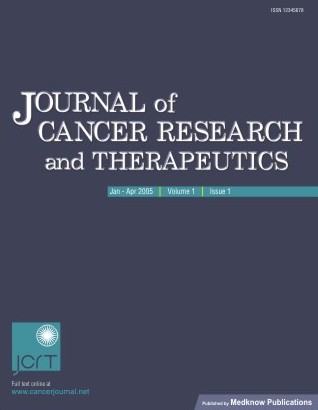
|
Journal of Cancer Research and Therapeutics
Medknow Publications on behalf of the Association of Radiation Oncologists of India (AROI)
ISSN: 0973-1482
EISSN: 0973-1482
Vol. 5, No. 4, 2009, pp. 240-246
|
 Bioline Code: cr09060
Bioline Code: cr09060
Full paper language: English
Document type: Research Article
Document available free of charge
|
|
|
Journal of Cancer Research and Therapeutics, Vol. 5, No. 4, 2009, pp. 240-246
| en |
Dose optimization of intra-operative high dose rate interstitial brachytherapy implants for soft tissue sarcoma
Jamema, Swamidas V.; Sharma, Pramod K.; Sharma, Dayananda; Laskar, Siddhartha; Deshpande, Deepak D. & Shrivastava, Shyam K.
Abstract
Objective: A three dimensional (3D) image-based dosimetric study to quantitatively compare geometric vs. dose-point optimization in combination with graphical optimization for interstitial brachytherapy of soft tissue sarcoma (STS).
Materials and Methods: Fifteen consecutive STS patients, treated with intra-operative, interstitial Brachytherapy, were enrolled in this dosimetric study.
Treatment plans were generated using dose points situated at the "central plane between the catheters", "between the catheters throughout the implanted volume", at "distances perpendicular to the implant axis" and "on the surface of the target volume"
Geometrically optimized plans had dose points defined between the catheters, while dose-point optimized plans had dose points defined at a plane perpendicular to the implant axis and on the target surface. Each plan was graphically optimized and compared using dose volume indices.
Results: Target coverage was suboptimal with coverage index (CI = 0.67) when dose points were defined at the central plane while it was superior when the dose points were defined at the target surface (CI=0.93). The coverage of graphically optimized plans (GrO) was similar to non-GrO with dose points defined on surface or perpendicular to the implant axis. A similar pattern was noticed with conformity index (0.61 vs. 0.82). GrO were more conformal and less homogeneous compared to non-GrO. Sum index was superior for dose points defined on the surface of the target and relatively inferior for plans with dose points at other locations (1.35 vs. 1.27).
Conclusions: Optimization with dose points defined away from the implant plane and on target results in superior target coverage with optimal values of other indices. GrO offer better target coverage for implants with non-uniform geometry and target volume.
Keywords
3D image based dosimetry, graphical optimization, soft tissue sarcoma implants
|
| |
© Copyright 2009 Journal of Cancer Research and Therapeutics.
Alternative site location: http://www.cancerjournal.net/
|
|
